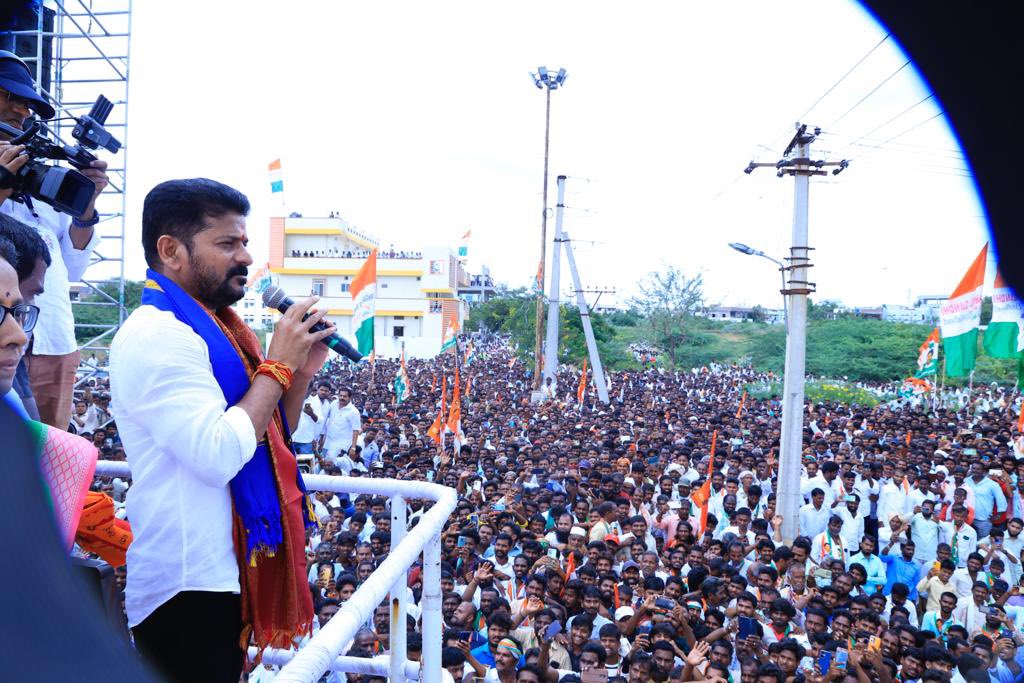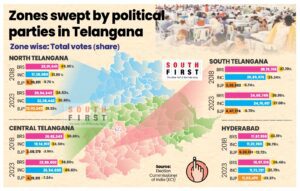Congress dominated the central and southern regions, the BJP envisions a future in North Telangana, and BRS held sway in GHMC region.

A Revanth Reddy addressing a gathering before filing his nomination papers in Kodangal. (X)
After sweeping the third Telangana elections Assembly elections with a clear majority, the Congress assumed power on Thursday, 7 December. Not considered the principal Opposition till a few months ago, the grand-old party won 64 seats against the arch-rival BRS, which was limited to 39 seats.
The BJP, the third mainstream party in the state, did handsomely for itself. It secured eight seats — seven more than it won in 2018 and five more than its strength in the outgoing Assembly.
South First puts together how these political outfits performed across different regions in the state. We also compare their current performance with the 2018 Assembly polls — the number of seats, the vote share, and the factors behind their dominance in the particular region.
The northern part of Telangana comprises Adilabad, Jagtial, Jayashankar Bhupalpalle, Kamareddy, Karimnagar, Kumaram Bheem Asifabad, Mancherial, Mulugu, Nirmal, Nizamabad, Peddapalle, and Rajanna Sircilla districts, constituting 33 constituencies.
In 2018, the BRS won 26 out of the 33 seats, Congress bagged five, and one each went to the BJP and the All India Forward Bloc (AIFB).
The BRS achieved a vote share of 45.99 percent, followed by Congress’s 31.96 percent. The BJP garnered an impressive 9.76 percent vote share — its highest among all the three zones.

Telangana political parties performance in zonal wise (includes also seats that were contested in alliance with respective parties)
However, in 2023, the saffron party faced setbacks as its three MPs and a chief ministerial face lost their Assembly seats—Boath (Soyam Bapu, Adilabad MP), Koratla (Aravindh Dharmapuri, Nizamabad MP), Karimnagar (Bandi Sanjay, Karimnagar MP), and Eatala Rajender in Huzurabad.
But what came out as a surprise is that out of the total eight Assembly seats the BJP remarkably won in the Telangana elections this year, seven came from this northern zone.
According to the Election Commission of India (ECI) data, BRS won a mere nine seats, consolidating a vote share of 34.53 percent. Among its opponents, the Congress secured 17 seats with a vote share of 36.90 percent, while the BJP won seven seats with a 21.32 percent vote share.
Though the Congress won more seats in this zone, the BJP has doubled its vote share from the earlier nine percent.
Explaining the rise of the BJP in Northern Telangana, Prof E Venkatesu from the Department of Political Science at the University of Hyderabad and a member of CSDS Lokniti, told South First, “The announcement of the Turmeric Board months before the polls played a key role, especially since there is a high number of people dependent on it in and around Nizamabad. Another possible reason was the Modi card and his performance, which yielded results for the state BJP.”
He noted that, additionally, the candidates contesting here were new faces addressing local issues.
“Consequently, people turned to the BJP, especially in constituencies where the incumbent MLA and MPs were defeated due to their non-performance. The rise of the BJP, coupled with the popular notion of bringing development, is attributed to addressing the lack of development and welfare schemes in the northern region by the other two parties,” Venkatesu opined.
On asking why the Turmeric board factor didn’t work for the three BJP MPs and the MLA who lost from this zone, he opined it was due to their individual performances.
In Central Telangana, South First analysed nine districts: Sangareddy, Medak, Siddipet, Jangaon, Warangal Urban, Warangal Rural, Mahabubabad, Bhadradri Kothagudem, and Khammam, which collectively consist of 30 constituencies.
During the 2018 Assembly elections, the BRS, led by former chief minister K Chandrashekar Rao, secured 19 out of the 30 seats here, with a vote share of 50.60 percent.
In alliance with the TDP, CPI, and TJS, the Congress came next, winning nine constituencies and a vote share of 34.50 percent. The BJP clinched only one Assembly seat, Dubbaka, in a by-poll with an overall vote share of 3.96 percent, while an Independent candidate won the Wyra constituency.
However, in a reversal of events in the 2023 elections, the BRS saw a reduction in seats to 10 from 19, accompanied by a decreased vote share of 39.50 percent — 11 percentage points less than the previous elections.
In these elections, Congress claimed 21 seats, more than twice its number in 2018, with a vote share of 45.82 percent, which is an 11 percentage point increase from last time.
The BJP lost its lone seat in this zone (Dubbaka), but saw a rise in its vote share to 7.24 percent from the earlier 3.96 percent.
Prof Venkatesu explained that the significant downfall of the BRS was because most of the region was surrounded by Hyderabad, and peripheral areas voted against the Hyderabad model of development.
“Instead of witnessing progress, people believed other places are not developing, and a significant portion of resources was directed solely towards Hyderabad. This issue was also one of the reasons for the creation of Telangana but remains unresolved,” he said.
Venaktesu added that, moreover, the decline of the BRS can also be attributed to the lack of dispersal of welfare schemes and unemployment. “This is evident in the Lokniti reports, too, which indicate that only 50 percent of popular welfare schemes were reaching the intended recipients,” he added.
The Southern Zone of Telangana has 32 constituencies in 11 districts — Vikarabad, Medchal Malkajgiri, Rangareddy, Mahabubabad, Nalgonda, Suryapet, Nagarkurnool, Wanaparthy, Yadadri Bhongiri, Mahbubnagar and Jogulamba Gadwal.
In the last Assembly elections, the pink party, in what is seen as its heartland, won a staggering 29 out of the 32 seats with a vote share of 47.7 percent. The Congress secured two seats with a vote share of 35.34 percent.
This time, the BRS won five seats with a 36.96 percent vote share — over a 10 percentage point reduction — as it lost 24 seats.
On the other hand, Congress won 27 seats in comparison to five from last time, with a vote share of 37.08 percent. But, regarding the vote share, the Congress got a minor increase.
The Congress party’s vote share, which was 35.34 percent in 2018, is now 37.08 percent — an increase of 1.74 percentage points. While the BJP drew a blank, its vote share has increased from 5.74 percent to 6.40 percent.
Professor Chakrapani Ghanta, who serves as the Director of Academics and a Professor of Sociology at Dr BR Ambedkar Open University in Hyderabad, told South First, “A factor that worked for the Congress’s performance in these areas was the presence of prominent leaders such as Revanth Reddy, Uttam Kumar Reddy, Komatireddy Venkata Reddy, and Jana Reddy from the region led to numerous defections to the Congress from other parties. Consequently, it worked well in gaining seats from the BRS.”
On BRS retaining its decent vote share compared to other regions, Chakrapani opined that the “irrigation and drinking projects such as Palamuru lift irrigation projects and Mission Bhagiratha have been significant in these areas, such as Nalgonda, which was once a fluoride-affected region”.
The most discussed and politically sensitive zone that attracts attention is the capital region, Hyderabad, but for the Congress, this zone has remained elusive.
In 2018, the ruling BRS secured victory in 14 seats with a vote share of 42.19 percent, while Congress only managed to secure two seats with a vote share of 26.78 percent. The BJP secured a single seat with a vote share of 12.72 percent, and the remaining seven seats were retained by the AIMIM.
However, in 2023, despite Congress winning 64 seats in other parts of the region, it failed to secure a single seat in the Hyderabad region and couldn’t retain its existing two seats. Also, it got the lowest vote share of 23.79 percent compared to other regions — which is three percentage points less than what it got in the 2018 elections.
Meanwhile, the AIMIM and BJP successfully retained their seats.
In these elections, BRS won 16 seats with a vote share of 38.46 percent. Congress secured no seats and witnessed a its vote share also reducing to 23.79 percent, while the saffron party secured one seat (Goshamahal) with a 22.37 percent vote share — an increase of around 10 percentage points from the last elections.
Professor Chakrapani Ghanta notes that in contrast to the rural belt, the Congress faced challenges in the Hyderabad region due to a lack of traditional leadership that historically held influence over the middle and lower-middle classes. “Notable leaders like Marri Sashidhar Reddy and the late P Janardhan Reddy, who had a stronghold in Sanathnagar and Khairatabad, respectively, are no longer associated with the Congress,” he said.
Addressing Andhra voters for not supporting Congress as anticipated by many analysts, the professor highlighted that labelling Andhra voters solely as Kammas, or associated with TDP Chief Chandrababu Naidu, is inaccurate.
“The Andhra electorate represents diverse communities, including Reddys, Kapus, Rajus, and other BC communities. The arrest of Chandrababu Naidu and the BRS response did not significantly impact the voters’ perception, with many considering the BRS government’s developmental efforts in Hyderabad as a crucial factor in their voting decision,” he added.

May 03, 2024

May 03, 2024

May 03, 2024

May 03, 2024

May 04, 2024

May 03, 2024